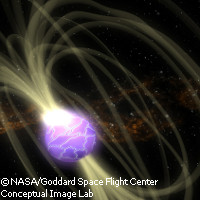Rare magnetic star comes out of hiding in spectacular style
An enormous eruption in space captured by several telescopes came from a rare type of star called a magnetar, an international team of scientists writes in the Monthly Notices of the Royal Astronomical Society. The magnetar, dubbed SGR 0501+4516, lies 15,000 light years from Earth and had remained undiscovered until its recent outpouring of energy gave it away. Magnetars have a magnetic field 10 billion times stronger than that of the Earth, making them by far the most highly magnetised objects in the universe. If a magnetar were placed half way between the Earth and the moon, for example, the magnetar's magnetic field would completely wipe out the details of every credit card on the planet. So far, only 15 magnetars have been identified in the whole galaxy. In this recent case, events began unfolding on 22 August 2008, when a burst of X-rays triggered an automatic sensor on the international Swift satellite. Just 12 hours later, the European Space Agency's XMM-Newton space observatory zoomed in on the source of the X-rays and began gathering data. Over the next four months, hundreds of smaller X-ray bursts were measured, allowing scientists to carry out the most detailed study of the decay of a magnetar. Meanwhile, the Integral space observatory detected highly energetic X-rays coming from the magnetar (beyond the energy range that XMM-Newton can see) five days after the first big eruption. These X-rays disappeared within 10 days. Magnetar outbursts take place when the unstable magnetic field pulls at the star's crust, releasing matter outwards in an immense eruption. This matter then becomes entangled in the magnetic field, changing its configuration and causing even more energy to be released. Even though they are far away, magnetar outbursts can supply as much energy to the Earth as solar flares from our own sun. 'Magnetars allow us to study extreme matter conditions that cannot be reproduced on Earth,' commented the lead author of the paper, Nanda Rea of the University of Amsterdam in the Netherlands. The precise origin of magnetars is a mystery. The most common theory is that they are the tiny core left behind after the death of a highly magnetic star, although there is no conclusive proof of this theory. 'If we could just find a magnetar in a cluster of highly magnetic stars, that would prove it,' said Dr Rea. The other theory is that when a normal star dies, its core is accelerated, creating a dynamo that strengthens its magnetic field and turns it into a magnetar. Although the astronomers plan to continue with their hunt for more magnetars, their work with SGR 0501+4516 is not over; now that they know where it is, XMM-Newton will zoom in on it again next year so that astronomers can study it while it is in its resting state.



